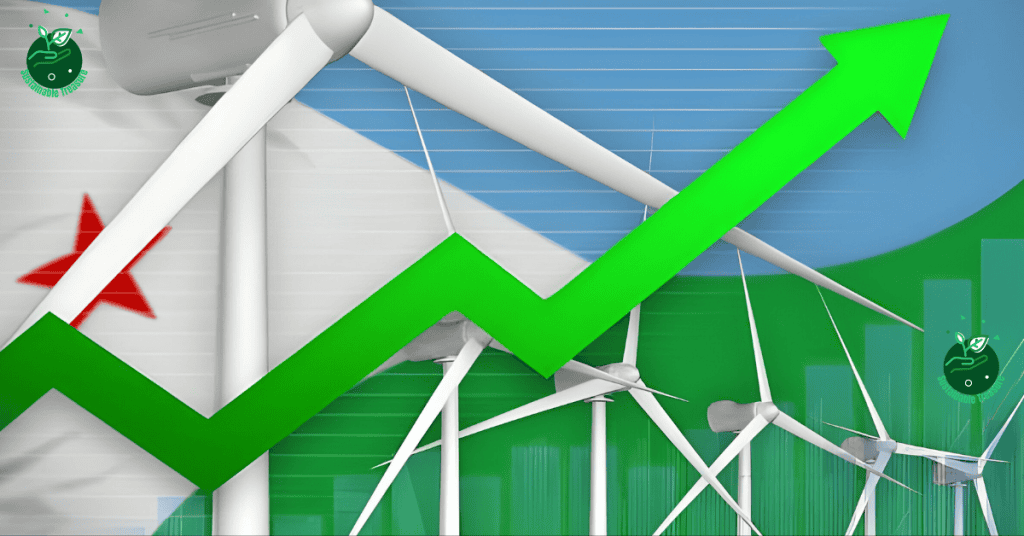Table of Contents
Did you want to know the different between Impact Investing vs. Financial Returns? Yes, Impact investing combines the pursuit of financial returns with the intentional effort to generate positive social and environmental impacts.
I distinctly remember the shareholder meeting where I asked my father’s friend John, a successful hedge fund manager, whether pursuing social and environmental impact requires sacrificing profits.
He pushed back passionately, arguing that in fact the opposite holds true – integrating impact analysis to identify risks, seize opportunities and guide capital towards scalable solutions drives superior long-term outperformance.
In this in-depth blog post, we’ll analyze the latest evidence and landscape shaping the debate between prioritizing measurable impact goals versus maximizing financial performance.
Can investors really have their cake and eat it too when it comes to returns in impact portfolios? Read on for the key research, trends, and voices you need to make sense of it all.
The Rise of Impact Investing
Impact investing refers to investments “made with the intention to generate positive, measurable social and environmental impact alongside a financial return”. It encompasses everything from responsible screens that filter out objectionable sectors, to proactively targeting companies driving sustainability solutions.
Key Players Driving Demand
The Global Impact Investing Network (GIIN), a nonprofit dedicated to increasing capital flows for impact, sizes the current global market at $715 billion with expectations to reach $1 trillion by 2025. What’s behind the hockey stick growth forecasts even amidst turbulent markets?
- Millennials now represent the largest share of working-age adults globally. Surveys consistently show higher preferences amongst millennials for aligning investments with values through approaches like ESG integration and impact investing. Their wealth and influence will only continue to accelerate growth.
- Women also make up a crucial driving force for impact investing demand. Research suggests women exhibit higher risk aversion in portfolio allocation and stronger desires to reflect social causes they care about. As female wages and control of capital rises further, so will capital flows towards impact.
- Institutional Players from pension funds to private banks have responded to younger client demands by making impact investing products more accessible. BlackRock, the world’s largest asset manager with over $10 trillion in assets, made waves announcing initiatives to expand sustainable index offerings and press companies for greater ESG disclosures.
Driving Public Policy
Governments have also helped fan the flames of interest in impact through policy initiatives and pronouncements orienting capitalism in a more sustainable direction:
- The UN Sustainable Development Goals (SDGs) established a globally endorsed 15-year plan targeting socio-economic-environmental priorities like climate action and zero poverty. Asset owners and managers frequently align impact objectives with advancing specific SDGs.
- The EU Sustainable Finance Action Plan aims to reorient over €1 trillion of assets towards sustainable objectives annually through regulation, reporting rules, and classification systems.
- In the U.S., the Department of Labor ruled retirement plan fiduciaries can consider ESG factors when evaluating investments, removing a barrier to consideration.
This policy momentum signals impact investing becoming more mainstream, not just a niche movement.
Impact Investing Growth Projections
| Year | Estimated Size | Growth vs. Prior Year |
| ------------- |:-------------:|-------------:|
| 2018 | $502B | |
| 2019 | $585B | +16% |
| 2025 (projected) | $1T | +71% |(Source: GIIN 2020 Annual Impact Investor Survey)
Clarifying Goals: Impact First or Finance First?
Under the big umbrella term of “impact investing”, experts make an important distinction between funds that lead with measurable impact goals versus those prioritizing financial performance.
Impact First
Impact-first (or “impact-led”) funds orient investment processes around evidence-based impact targets, selecting companies well-positioned to contribute solutions. They anchor portfolio construction methodology to intentionally maximize target impact results.
Financial return expectations in impact-first funds tend to be below general market benchmarks or closer to market-rate fixed income returns in the low single digits. Subsidized or non-commercial capital often catalyzes this segment.
Spotlight: The Nature Conservancy launched a $100 million NatureVest impact investing unit that has financed sustainable agriculture, forestry, eco-tourism, and other conservation-friendly ventures. Their success informed TNC’s additional $1 billion commitment to further scale conservation impact investing globally.
Finance First
In finance-first (or “finance-led”) funds, impact serves as an additional lens or overlay within a predominately conventional investment process still ultimately measured by financial return metrics. Managers apply ESG integration techniques like positive screening and shareholder advocacy as tools to reduce risk and improve returns.
Given the primary goal of competitive risk-adjusted returns, finance-first funds largely cluster in the market-rate-seeking impact category rather than concessionary return territory. Their capital typically comes from institutional and accredited investors rather than subsidized sources.
Spotlight: Generation Investment Management, the sustainability-focused fund co-founded by former Vice President Al Gore and Goldman Sachs asset management head David Blood, manages over $36 billion in growth equity accumulation and credit strategies. The team integrates material ESG factors while still targeting top quartile performance relative to traditional benchmarks.
So how do self-identified impact investors overall prioritize between the dual objectives of impact and returns in the portfolios they manage? GIIN survey data suggests a spectrum of relative weighting:

Over half of respondents view impact and returns as completely aligned. But a segment does see inherent tension between depth of impact and financial results which influences their orientation.
Returns in Context: Market-Rate, Reduced, and Subsidized

Pinpointing evidence on returns turns out to be one of the thorniest (and most debated) issues in the evolving impact marketplace. Extremely wide dispersion exists underneath aggregated sector performance.
In GIIN’s 2020 investor survey, the majority of respondents target risk-adjusted market rate returns comparable to conventional alternatives:
But other investor impact portfolios, especially those focused on more nascent markets like off-grid clean energy in emerging economies, incorporate reduced returns through catalytic concessionary capital. This high-risk patient funding helps validate business models and spur future commercial investment.
Market-rate and subsidized impact investing occupy different positions on the returns continuum but work symbiotically. Blended finance structures allow catalytic philanthropic and public dollars to mobilize larger institutional capital flows toward the SDGs. JPMorgan Chase’s guidance succinctly captures the interplay:
“Organizations can use philanthropic and/or government resources to absorb risks that commercial investors aren’t able—or willing—to accept, which then ‘crowds in’ private capital.”
So rather than a strict dichotomy between financial returns and impact, the reality resembles an ecosystem of capital along a spectrum. Asset owners and managers array their risk-return-impact preferences across this continuum based on specific objectives.
The Mechanics of Impact Value Creation
If well-executed, integrating impact analysis and management can improve financial results beyond just feeling good. The ways this can manifest fall into three main buckets:
1. Risk Mitigation
Proactively assessing environmental, social, and governance (ESG) factors provides investors an added lens for due diligence to avoid risks invisible on the surface. Examples across asset classes abound:
- Public equities: ESG scrutiny helps investors avoid stranded asset risk, litigation liabilities, reputational crises, regulatory fines, and other headaches dimming corporate prospects. Sustainable funds often outperform counterparts during market turmoil.
- Private equity: Operational upgrades on elements like energy efficiency and supply chain ethics create direct cost savings and improved profitability. Especially effective for private company investments with higher access to implement changes.
- Fixed income: Green bond issuances that fund climate-aligned projects like renewable energy and green buildings provide higher certainty of achieving cashflow for debt repayments.
2. Revenue Growth
Pursuing social and environmental impact also opens up new market opportunities that enhance top-line revenue growth. Examples include:
- Premium pricing for sustainably produced goods like organic food and clothing
- Market share gains as impact-driven brands resonate with conscientious consumers
- First-mover advantages in fast-growing categories like plant-based meat products
- Sales from environmental credit offsets like renewable energy certificates (RECs)
3. Multiple Expansion
The market continues to more highly value companies contributing solutions to global challenges. This allows for faster growth trajectories, higher terminal values, and expanded valuation multiples on successful exits:
- Premium acquisition valuations realized in sectors like clean tech (Boston-Power’s 9x revenue exit) and plant-based meat (Beyond Meat’s 18x revenue IPO valuation)
- Mainstream brands launching impact-focused business lines to capture segment share and improved earnings multiples
Integrating impact analysis serves as an offensive market differentiator, beyond just defense. Pursued diligently by allocating capital to value-creating opportunities, impact portfolios can compete at the top tier of financial performance.
But generic “impact washing” claims without backing evidence poses major risks. Let’s explore the crucial role impact measurement and management plays.
Impact Measurement Entering the Mainstream
Historically companies, investors, and funds made impact claims without much accountability. But in recent years the industry has coalesced around common reporting standards and best practices.
Wide dispersion still exists in methodology sophistication. But momentum clearly points towards impact metrics no longer being nice-to-have marketing fluff, but integral portfolio analytics required to identify risks, seize opportunities, and maximize performance.
Global Standards
In asset management, the UN Principles for Responsible Investment emerged as an early leader establishing a framework for integrating ESG factors backed by investor signatories managing over $100 trillion in AUM. This laid the foundation for transformation but lacked granular detail on defining and quantifying impact.
More recently, GIIN developed the IRIS catalog of widely adopted impact performance metrics across common categories like affordable housing, sustainable agriculture, clean energy access, small business financing, and health products for those in need. IRIS metrics quantify operational performance like:
- Tons of greenhouse gas emissions avoided
- Liters of safe drinking water provided
- Acres of wildlife habitats conserved
- Kilowatt hours of renewable energy generated
- Numbers of smallholder farmers assisted
- Micro-loans extended to women entrepreneurs
For each deal and underlying portfolio company, investors select relevant IRIS metrics to track tied to the specific impact thesis. This paints a dashboard monitoring progress towards targeted problem-solving results.
Creating universal impact metrics has proved complicated. But pressure mounts for accurate measurable contribution towards issues like climate action progress and inclusive prosperity gains.
Sourcing Validated Impact
Quantifiable impact metrics serve a dual purpose for asset owners and managers:
- Risk Management: Protect against potential “impact washing” greenwashing claims through evidence-based impact diligence validating additionality and monitoring ongoing progress
- Value Creation: Source and diligence promising impact alpha opportunities with market validated business models selling socio-environmental solutions
This impact diligence provides offensive and defensive benefits – when executed effectively.
The industry now boasts advisory firms focused on quantifying impact claims and contribution for clients. BlueMark offers a representative model providing analysis on elements like impact risk classification, SDG alignment, and verification of additionality principles. Their ratings help managers source compelling impact deals and integrate monitoring for value preservation.
Tools like GIIN’s Navigating Impact Project Checklist also guide investors on aligning impact strategy with the SDGs based on intensity criteria like:
- Evidence linking business model impact to positive outcomes
- Verification of progress monitoring systems
- Proven management commitment to impact
Premium for Impact Alpha
This professionalization of standards and impact diligence in theory will allow the highest performing “impact alpha” opportunities to potentially warrant a valuation premium.
Just as traditional hedge fund alpha over performance versus benchmarks earns outsized returns, the top impact managers driving measurable progress business models on issues like renewable energy access in emerging markets or sustainable smallholder agriculture could justify higher earnings multiples.
Critics argue impact premiums reflect hype detached from actual value creation. But impact alpha appears no different than traditional sectors where leading managers earn premiums for driving transformational solutions to proven market needs (think Airbnb for lodging or Beyond Meat for sustainable protein).
Savvy impact managers and asset owners will need to separate hype from substance just as traditional investors do during bull markets.
The question remains whether impact alpha can prove durable or risks getting competed away over longer time horizons as more capital enters top impact themes.
Time will tell but the opportunity appears vast given quotients like over 3 billion people still lacking access to reliable electricity globally.
Key Takeaways
So where does the debate on impact investing vs. financial returns stand given the range of perspectives and priorities across the ecosystem?
Key conclusions include:
- Substantial evidence demonstrates market-rate risk-adjusted returns can be achieved through leading impact funds, especially via ESG integration and positive screening approaches. Critics argue higher due diligence costs on impact factors diminish ultimate net returns, but data appears mixed.
- Below market-rate returns prevail in certain impact fund segments, especially earlier stage venture capital managers focused on developing world investments like off-grid solar energy or mobile banking. These funds deliver societal value but given higher risk profiles depend substantially on catalytic philanthropy and public sector capital to mobilize additional commercial investment through innovative deal structures.
- Custom benchmarking aligned to impact fund geographic and asset class exposures remains essential for appropriate performance evaluation. Chasing overall private equity index returns proves flawed for emerging markets-focused impact funds pursuing more nascent opportunities. But market-rate returns have been demonstrated in several impact-first funds against appropriately constructed impact benchmarks.
- Opportunities likely exist for truly top-tier impact managers to generate alpha through proprietary analytics identifying value creation opportunities faster and more accurately than competitors. This impact alpha would theoretically warrant above market return premiums over time, but has not yet been definitively proven.
The conclusion that impact portfolios fail to keep pace with returns appears too sweeping. But certainly a spectrum of expectations exists based on relative prioritization of measurable impact goals vs financial hurdles. Higher transparency and disclosures will help clarify realistic return patterns across difference investment methodologies.
FAQs

What Is The Average Return On Impact Investing?
Determining average returns for impact investing as a whole proves challenging given the wide range of asset classes, geographies, and investment approaches lumped under one term. But research suggests pockets of market-rate returns exist depending on strategy.
For example, the Global Impact Investing Network’s 2020 Annual Investor Survey showed 59% of respondents targeting risk-adjusted market-rate returns between 5-15% similar to conventional alternatives.
Additionally, a growing body of evidence shows integration of environmental and social factors within a disciplined investment process can lower portfolio risk and improve returns over the long run.
However, sectors like seed-stage companies delivering fundamental services like clean water access or renewable electricity in emerging economies frequently depend on catalytic philanthropy averaging closer to low single digit returns.
The range of financial expectations depends greatly on impact goals and risk tolerance. But market-rate returns appear feasible.
What Is Another Name For Impact Investing?
Impact investing overlaps with other acronyms like ESG (environmental, social, governance) investing, sustainable investing, values-aligned investing, and mission-aligned investing. The unifying theme revolves around consideration of societal factors and benefits beyond pure profit.
Specifically, ESG investing incorporates issues like climate risks, board diversity, and ethical supply chains as an additional lens within a conventional investment process. Sustainable investing focuses on companies driving solutions. The terminology lacks standardization but continues to converge towards a consistent framework.
Is Impact Investing Profitable?
Yes – impact investing can certainly prove profitable with market-rate financial returns, depending on strategy. The key factors include:
- Asset Class: More established public equities impact funds using ESG integration focused on risk mitigation tend to perform in-line with benchmarks. Higher risk private market impact funds chasing earlier opportunities normally target below market returns relying more on outright grants and below market investments.
- Tools: Adherence to impact measurement standards like IRIS and GIIN’s Navigating Impact framework help investors set targets and track performance. This facilitates sourcing investments poised to balance financial sustainability and social/environmental progress.
- Alpha: Particularly skilled impact fund managers able to accurately value impact-driven companies earlier than markets using proprietary diligence and analytics have proven the ability to generate alpha (risk-adjusted excess returns relative to benchmarks). But data still compiles to definitively quantify alpha generation potential over multi-year periods for top-tier teams.
Can You Make Money From Impact Investing?
Yes, money can be made from impact investing just as from conventional investing depending on asset classes, security selection, and time horizons. Specific examples of competitive risk-adjusted returns include funds focused on themes like:
- Sustainable real assets (green buildings, eco-certified forestry)
- Historical financial outperformance of higher ESG-rated public equities
- Premium pricing and lower customer churn for purpose-led brands
Additionally, first-mover opportunities exist for savvy impact investors providing early growth financing to validated business models tackling societal problems.
Just as early VC backing of transformative companies like Airbnb and Beyond Meat generated alpha before mainstream recognition, impact alpha available for disciplined security selectors identifying truly scalable solution-providers.
What Are The Risks Of Impact Investing?
Impact investors face typical economic risks inherent to any investment like underlying business model execution and financial management. But additional hazards specific to impact portfolios also exist including:
Underperformance Risk
- Possibility for lower returns than conventional benchmarks if impact goals misaligned with value drivers
Impact Washing Risk
- Investments failing to create meaningful or measurable impact despite marketing claims
Private Markets Risk
- Long lock-up periods reducing liquidity coupled with uncertainty for emerging sector companies commercializing unproven technologies
The key lies in portfolio construction hedging risks through diversification across geographies, asset classes, and impact objectives aligned to financial return expectations.
What Are The Benefits Of Impact Investing?
Beyond financial upside, impact investing provides investors opportunities to align capital with personal values and addressing global priorities like climate action, empowering women, quality education and more.
Further advantages include:
- Diversification into faster growing market segments addressing socio-environmental mega-trends
- Risk Mitigation through considering ESG factors invisible to conventional financial analysis
- Innovation Pipeline providing early backing for breakthrough solutions to tackle pressing issues
- Psychic Income from contributing to issues investors care deeply about
The strategic benefits beyond feel-good factors depend greatly on portfolio construction methodology and manager selection.
What Is The Difference Between Esg And Impact Investing?
While substantial overlap exists, some distinctions emerge between ESG investing and impact investing including:
ESG Investing
- Focuses on risk mitigation and return optimization
- Applies negative screening (exclusions) and integration of extra-financial factors
- Scope limited to existing portfolio holdings
- Aims to incrementally improve business practices
Impact Investing
- Leads with measurable impact goals tied to financing solutions
- Involves targeted proactive security selection
- Provides growth capital to catalyze market-based approaches improving lives
- Accepts discounted returns for higher impact exposure
Both ESG and impact investing consider environmental and social implications, but orient around different primary aims. Hybrid approaches also exist on a continuum balancing financial and impact performance.
How Big Is The Impact Investing Market?
The Global Impact Investing Network (GIIN) estimates the current global impact investing marketplace at $715 billion in assets under management as of 2020.
Market growth projections call for continued rapid acceleration approaching over $1 trillion by 2025 through rising participation from retail investors to large institutions.
Impact investing growth drivers include increasing interest from women and millennials in aligning finances with values, climate change and sustainability megatrends, and greater access through mainstream wealth and asset managers.
This positions impact investing to potentially emerge from niche status to a normalized investment practice over the coming decade.
What Are Impact Investment Activities?
Investors allocate impact capital across traditional asset classes from cash equivalents to public stocks and private markets, but directed towards companies and funds delivering solutions. Examples include:
Public Equities
- Positive screening sustainable ETFs (ESG Leaders, Clean Energy Index)
- Engaging shareholders through proxy voting and resolutions
Fixed Income
- Green bonds financing certified climate-aligned projects
- Gender bonds directing capital to women empowerment initiatives
Private Markets
- Private equity/VC funds focused on pillars like renewable energy, microfinance, sustainable agriculture, health access, affordable eco-housing
- Direct private debt financing to impact-centric small and medium-sized enterprises
This just touches the surface of the range of opportunities to direct investments towards impact across the capital spectrum. The unifying thread centers on contributing towards measurable human, social, and environmental progress beyond just financial return.
Conclusion: Can impact portfolios produce returns rivaling traditional alternatives?
Revisiting this central question on impact investing’s relationship with financial returns, we’ve surveyed extensive evidence and perspectives across the ecosystem.
While return expectations vary based on precise impact objectives, integrating environmental and social factors as an additional lens guiding security selection and portfolio construction appears poised to emerge as an investment best practice based on competitive risk-adjusted return potential over relevant time horizons.
As aligning capital with values moves from niche status towards a mainstream imperative, I invite you to reflect on your financial priorities and explore where opportunities exist to contribute to issues you care deeply about. The possibilities sit at the intersection of heart and wallet.



